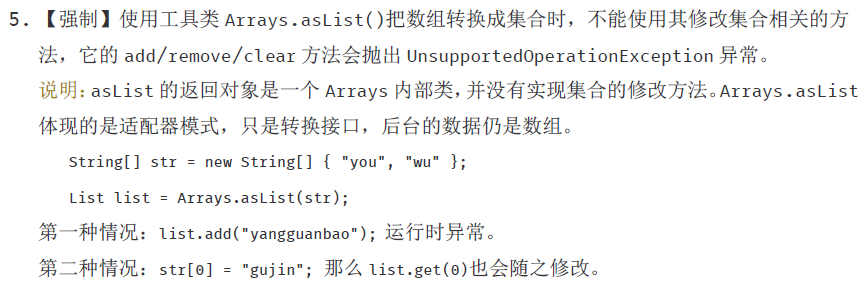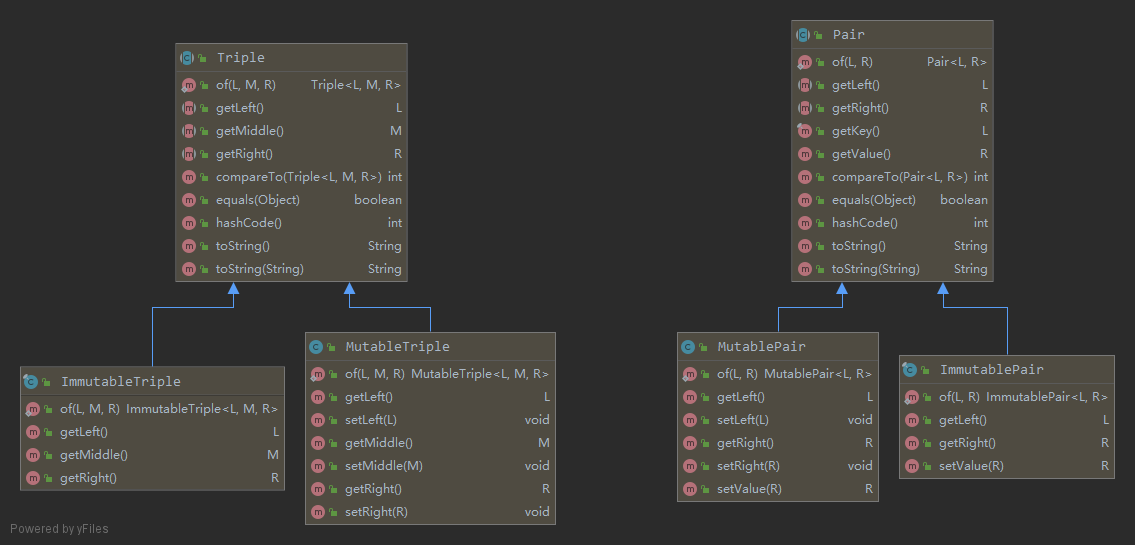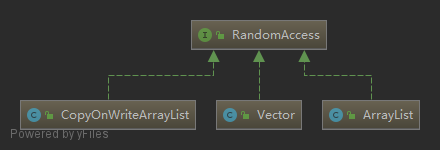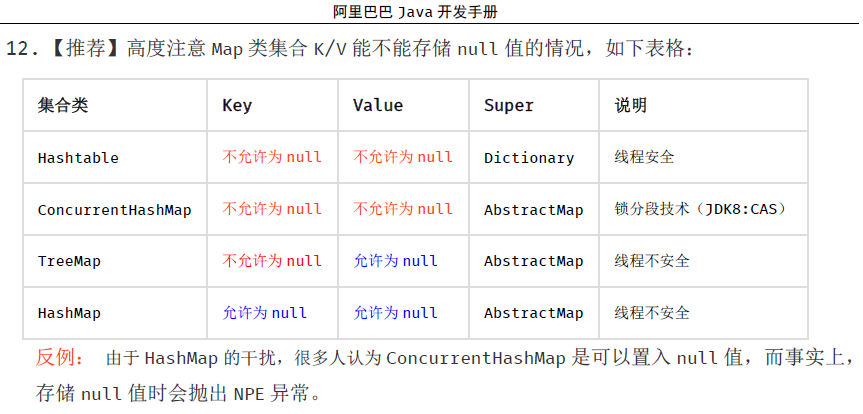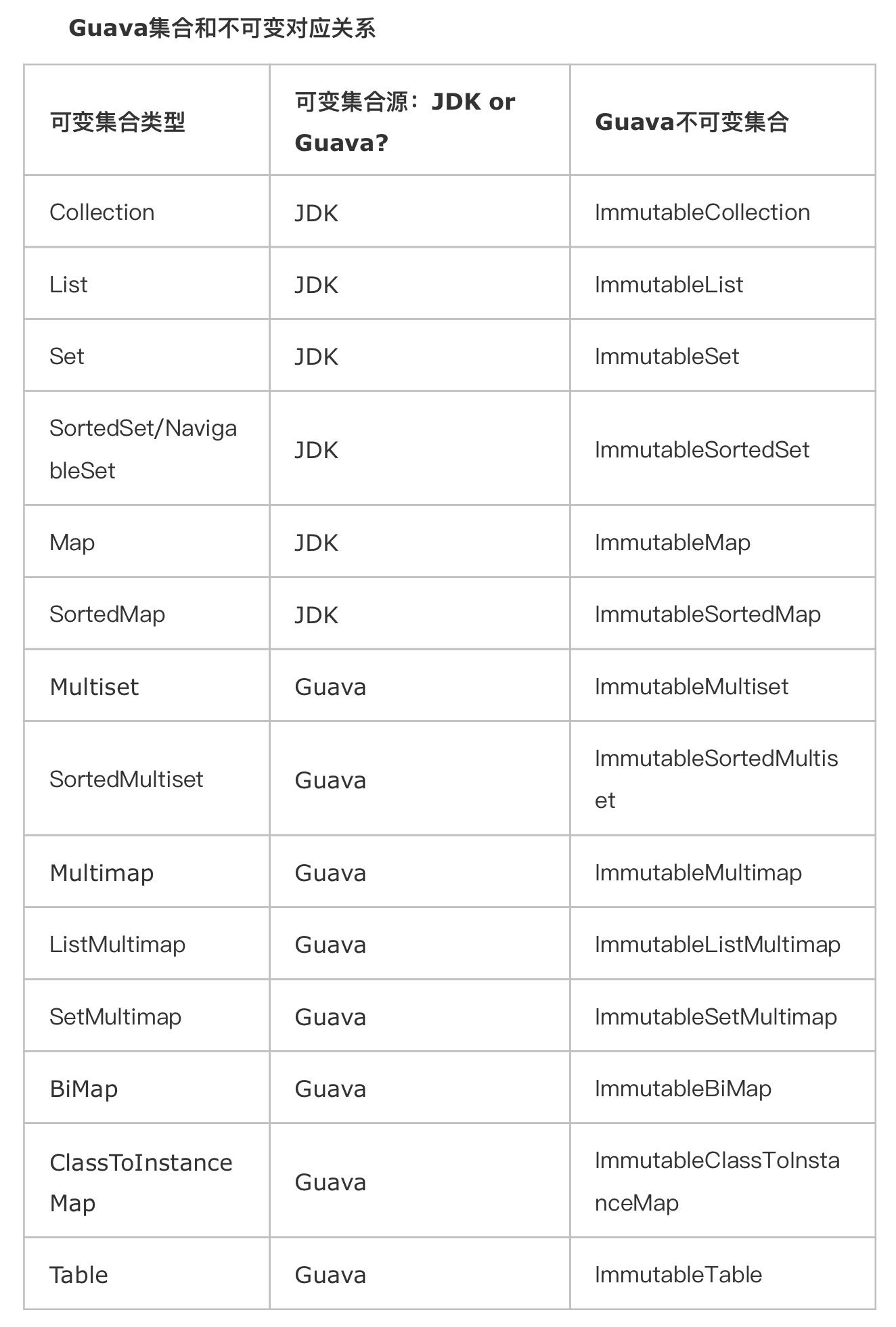集合接口中的许多修改方法都被标记为可选(optional) 。实现类允许按需实现,未实现的方法需抛出运行时异常 UnsupportedOperationException。每个实现类的文档必须指明支持哪些可选操作。集合框架引入下列术语来帮助阐述本规范:
定长/变长 长度保证不变(即使元素可以更改)的列表称为 fixed-size variable-size
开发中接触最多的定长集合是通过 Arrays.asList() 创建的,该方法是一个适配器接口,将数组适配为定长列表,返回的对象是一个 Arrays 内部类,源码如下:
1 2 3 4 5 6 7 8 9 10 11 12 13 14 15 16 17 18 19 20 21 22 23 24 25 26 27 28 29 30 31 32 33 34 35 36 @SafeVarargs @SuppressWarnings("varargs") public static <T> List<T> asList (T... a) { return new ArrayList <>(a); } private static class ArrayList <E> extends AbstractList <E> implements RandomAccess , java.io.Serializable { private static final long serialVersionUID = -2764017481108945198L ; private final E[] a; ArrayList(E[] array) { a = Objects.requireNonNull(array); } ...... }
分析发现,涉及元素增删的操作(如 add()、remove()、clear())该内部类并没有实现,而是使用了父类 AbstractList 的方法,默认抛出 UnsupportedOperationException 异常:
1 2 3 4 5 6 7 8 9 10 11 public abstract class AbstractList <E> extends AbstractCollection <E> implements List <E> { public void add (int index, E element) { throw new UnsupportedOperationException (); } public E remove (int index) { throw new UnsupportedOperationException (); } }
参考手册:
可改/不可改 不支持修改操作(例如 add、remove 和 clear)的集合称为 unmodifiable modifiable Collections 工具类提供了一组静态工厂方法,用于包装并返回指定集合的不可修改视图(unmodifiable view ),如果尝试修改,则会抛出 UnsupportedOperationException:
1 2 3 4 5 6 7 8 Collections.unmodifiableCollection Collections.unmodifiableSet Collections.unmodifiableSortedSet Collections.unmodifiableNavigableSet Collections.unmodifiableList Collections.unmodifiableMap Collections.unmodifiableSortedMap Collections.unmodifiableNavigableMap
从源码分析,该包装类覆盖了所有修改方法并抛出异常 UnsupportedOperationException,实现非常简单:
1 2 3 4 5 6 7 8 9 10 11 12 13 14 15 16 17 18 19 20 21 22 23 24 25 26 27 28 29 30 31 32 33 static class UnmodifiableCollection <E> implements Collection <E>, Serializable { private static final long serialVersionUID = 1820017752578914078L ; final Collection<? extends E > c; UnmodifiableCollection(Collection<? extends E > c) { if (c==null ) throw new NullPointerException (); this .c = c; } public boolean add (E e) { throw new UnsupportedOperationException (); } public boolean remove (Object o) { throw new UnsupportedOperationException (); } public boolean addAll (Collection<? extends E> coll) { throw new UnsupportedOperationException (); } public boolean removeAll (Collection<?> coll) { throw new UnsupportedOperationException (); } public boolean retainAll (Collection<?> coll) { throw new UnsupportedOperationException (); } public void clear () { throw new UnsupportedOperationException (); } ...... }
可变/不可变 在 unmodifiable 的基础上,加之保证 Collection 实现类的底层数据为 final 的集合称为 immutable mutable
Java 9 为 List、Set 和 Map 接口提供了新的静态工厂方法,可以创建这些集合的不可变实例,如下:
1 2 3 List<String> list = List.of("apple" , "orange" , "banana" ); Set<String> set = Set.of("aggie" , "alley" , "steely" ); Map<String, String> map = Map.of("A" , "Apple" , "B" , "Boy" , "C" , "Cat" );
而 Java 9 之前,要实现不可变集合只能通过第三方库,例如用 Guava 实现相同效果:
1 2 3 List<String> list = ImmutableList.of("apple" , "orange" , "banana" ); Set<String> set = ImmutableSet.of("aggie" , "alley" , "steely" ); Map<String, String> map = ImmutableMap.of("A" , "Apple" , "B" , "Boy" , "C" , "Cat" );
Guava 提供的不可变集合 API 如下:
1 2 3 4 5 6 7 8 9 10 11 12 13 14 15 16 17 18 19 20 21 22 23 24 25 26 27 28 ImmutableAsList ImmutableBiMap ImmutableClassToInstanceMap ImmutableCollection ImmutableEntry ImmutableEnumMap ImmutableEnumSet ImmutableList ImmutableListMultimap ImmutableMap ImmutableMapEntry ImmutableMapEntrySet ImmutableMapKeySet ImmutableMapValues ImmutableMultimap ImmutableMultiset ImmutableRangeMap ImmutableRangeSet ImmutableSet ImmutableSetMultimap ImmutableSortedAsList ImmutableSortedMap ImmutableSortedMapFauxverideShim ImmutableSortedMultiset ImmutableSortedMultisetFauxverideShim ImmutableSortedSet ImmutableSortedSetFauxverideShim ImmutableTable
使用如下:
1 2 3 4 5 List<String> list = ImmutableList.of("apple" , "orange" , "banana" ); Set<String> set = ImmutableSet.of("aggie" , "alley" , "steely" ); Map<String, String> map = ImmutableMap.of("A" , "Apple" , "B" , "Boy" , "C" , "Cat" ); log.info("list={}, set={}, map={}" , fruits, marbles, map);
除此之外,Apache Commons Lang 也提供了两个好用的类 Pair 和 Triple,可用于存放指定个数的临时数据:
1 2 Triple.of("left" , "middle" , "right" ) Pair.of("left" , "right" )
线程同步/非同步 参考线程同步包装器
随机/顺序访问 支持根据下标索引快速(时间复杂度 0(1))访问元素的列表称为 random access sequential access
标记接口 java.util.RandomAccess 用于标记列表类支持随机访问,其实现类如下:
该标记接口使得 Collections 工具类中的通用算法实现能够据此更改其行为以提升性能:
binarySearchreverseshufflefillcopyrotatereplaceAllindexOfSubListlastIndexOfSubListcheckedList
以 binarySearch 为例,源码判断如下:
1 2 3 4 5 6 public static <T> int binarySearch (List<? extends Comparable<? super T>> list, T key) { if (list instanceof RandomAccess || list.size()<BINARYSEARCH_THRESHOLD) return Collections.indexedBinarySearch(list, key); else return Collections.iteratorBinarySearch(list, key); }
元素限制 某些集合实现限制了可以存储哪些元素。可能的限制包括:
元素不能为 null。
元素必须属于特定类型。
元素必须匹配某些断言。
尝试添加违反集合实现限制的元素将导致运行时异常,如 ClassCastException、IllegalArgumentException 或 NullPointerException。
能否为 null 参考手册:
类型限制 泛型机制虽然为集合提供了编译期类型检查,但仍然可以在运行期绕过此机制(通过反射也能绕过编译期类型检查):
1 2 3 4 5 6 7 8 9 10 11 12 13 public void test4 () { List<Integer> intList = Lists.newArrayList(1 , 2 , 3 ); add(intList); for (int item : intList) { log.info("result is {}" , item); } } private void add (List list) { list.add("4" ); }
集合框架提供了一组包装器实现:
1 2 3 4 5 6 7 8 9 Collections.checkedCollection Collections.checkedQueue Collections.checkedSet Collections.checkedSortedSet Collections.checkedNavigableSet Collections.checkedList Collections.checkedMap Collections.checkedSortedMap Collections.checkedNavigableMap
这些包装器实现用于返回指定集合的动态类型安全视图(dynamically type-safe view ),核心源码如下:
1 2 3 4 5 6 7 8 9 10 11 12 13 14 15 16 17 18 19 20 21 22 23 24 25 26 27 28 29 30 static class CheckedCollection <E> implements Collection <E>, Serializable { private static final long serialVersionUID = 1578914078182001775L ; final Collection<E> c; final Class<E> type; @SuppressWarnings("unchecked") E typeCheck (Object o) { if (o != null && !type.isInstance(o)) throw new ClassCastException (badElementMsg(o)); return (E) o; } private String badElementMsg (Object o) { return "Attempt to insert " + o.getClass() + " element into collection with element type " + type; } CheckedCollection(Collection<E> c, Class<E> type) { this .c = Objects.requireNonNull(c, "c" ); this .type = Objects.requireNonNull(type, "type" ); } public boolean add (E e) { return c.add(typeCheck(e)); } ...... }
以 add 方法为例,每次添加元素时,都会调用 typeCheck 私有方法进行类型检查,如果尝试添加错误类型的元素,则会抛出 ClassCastException,通过 fail fast 防止后续出错:
1 2 3 4 5 6 7 8 9 10 11 12 public void test () { List<Integer> intList = Collections.checkedList(Lists.newArrayList(1 , 2 , 3 ), Integer.class); add(intList); for (int item : intList) { log.info("result is {}" , item); } } private void add (List list) { list.add("4" ); }
参考 《Guava学习笔记:Immutable(不可变)集合 》
《Java 中的 Mutable 和 Immutable 》(en_US )
https://stackoverflow.com/questions/7713274/java-immutable-collections
Unmodifiable collections are usually read-only views (wrappers) of other collections. You can’t add, remove or clear them, but the underlying collection can change .
Immutable collections can’t be changed at all - they don’t wrap another collection - they have their own final elements.
